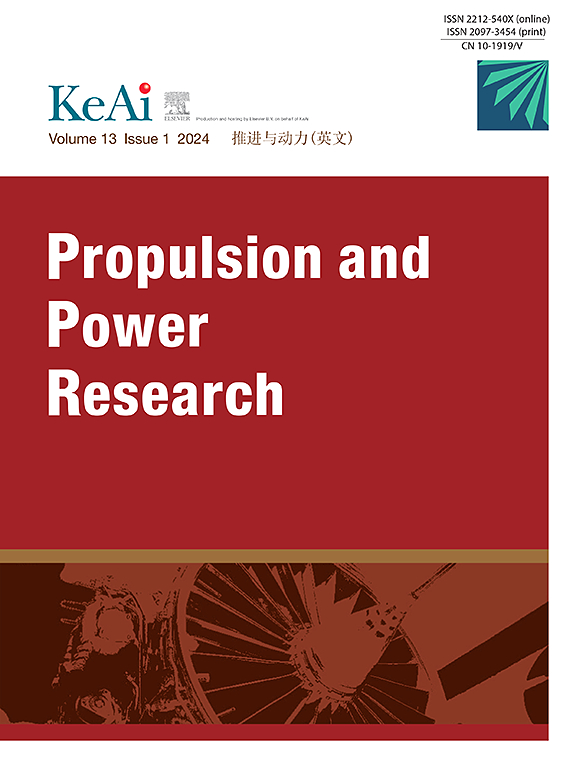Heat generation/absorption and bioconvective swirling stagnation point flow impact of magnetized Maxwell nanofluid by a stretchable rotating disk
IF 5.4
2区 工程技术
Q1 ENGINEERING, AEROSPACE
引用次数: 0
Abstract
The prime focus of this article is to formulate and inspect the mathematical model concerning the bioconvective swirling stagnation point flow of magnetized Maxwell nanofluid in the presence of gyrotactic motile microorganisms through a stretchable rotating disk. For the articulation of the heat transfer process, Fourier's law of heat conduction is implemented by incorporating heat sources and thermal radiation. The flow is further accompanied by the activation energy and solutal boundary conditions. The flow behavior for velocity, thermal, concentration, and microorganisms' volumetric density profiles are discussed in detail. Furthermore, heat and mass fluxes are explored by considering thermophoresis impact and Brownian movement through the Buongiorno model. The governing complicated nonlinear partial differential equations of flow are reduced into dimension-free ordinary differential equations by introducing some appropriate transformation variables. This problem is computed numerically by deploying the bvp4c built-in function in MATLAB. The impacts of concerned flow describing parameters are assessed by utilizing both graphical and tabulated approaches. The results elucidate the flow toward radial and azimuthal directions accelerated by increasing the stretching ratio parameter but decelerated by enlarging the magnetic field parameter. The thermal field strengthens against the increasing thermal radiation parameter, thermophoresis parameter, heat source parameters, and the thermal Biot number. The nanoparticles concentration profile is boosted for increasing magnitudes of thermophoresis number and solutal Biot number while it diminishes for enlarging Brownian movement parameter. The gyrotactic motile microorganisms' profile is downscaled by the Peclet and bioconvection Lewis numbers whereas an adverse tendency is noticed against the microorganism Biot number.
可拉伸旋转圆盘磁化麦克斯韦纳米流体的产热/吸收和生物对流漩涡滞止点流动影响
本文的主要重点是建立和检验磁化麦克斯韦纳米流体在回旋运动微生物存在下通过可拉伸旋转盘的生物对流旋流滞止点流动的数学模型。对于传热过程的表述,傅立叶热传导定律是通过结合热源和热辐射来实现的。流动还伴随着活化能和溶质边界条件。详细讨论了流速、热、浓度和微生物体积密度分布的流动特性。此外,通过Buongiorno模型考虑热泳冲击和布朗运动,探讨了热通量和质量通量。通过引入适当的变换变量,将控制复杂非线性流动偏微分方程简化为无量纲常微分方程。利用MATLAB中的bvp4c内置函数对该问题进行了数值计算。利用图形和表格两种方法来评估有关流描述参数的影响。结果表明,增大拉伸比参数可加速沿径向和方位方向的流动,增大磁场参数可减慢沿径向和方位方向的流动。热场随热辐射参数、热泳参数、热源参数和热Biot数的增加而增强。随着热泳次数和溶质Biot数的增大,纳米颗粒的浓度分布增大,而随着布朗运动参数的增大,纳米颗粒的浓度分布减小。旋向运动微生物的分布曲线被Peclet数和生物对流刘易斯数缩小,而对微生物的Biot数则有不利的趋势。
本文章由计算机程序翻译,如有差异,请以英文原文为准。
求助全文
约1分钟内获得全文
求助全文
来源期刊

Propulsion and Power Research
Multiple-
CiteScore
7.50
自引率
5.70%
发文量
30
期刊介绍:
Propulsion and Power Research is a peer reviewed scientific journal in English established in 2012. The Journals publishes high quality original research articles and general reviews in fundamental research aspects of aeronautics/astronautics propulsion and power engineering, including, but not limited to, system, fluid mechanics, heat transfer, combustion, vibration and acoustics, solid mechanics and dynamics, control and so on. The journal serves as a platform for academic exchange by experts, scholars and researchers in these fields.
 求助内容:
求助内容: 应助结果提醒方式:
应助结果提醒方式:


